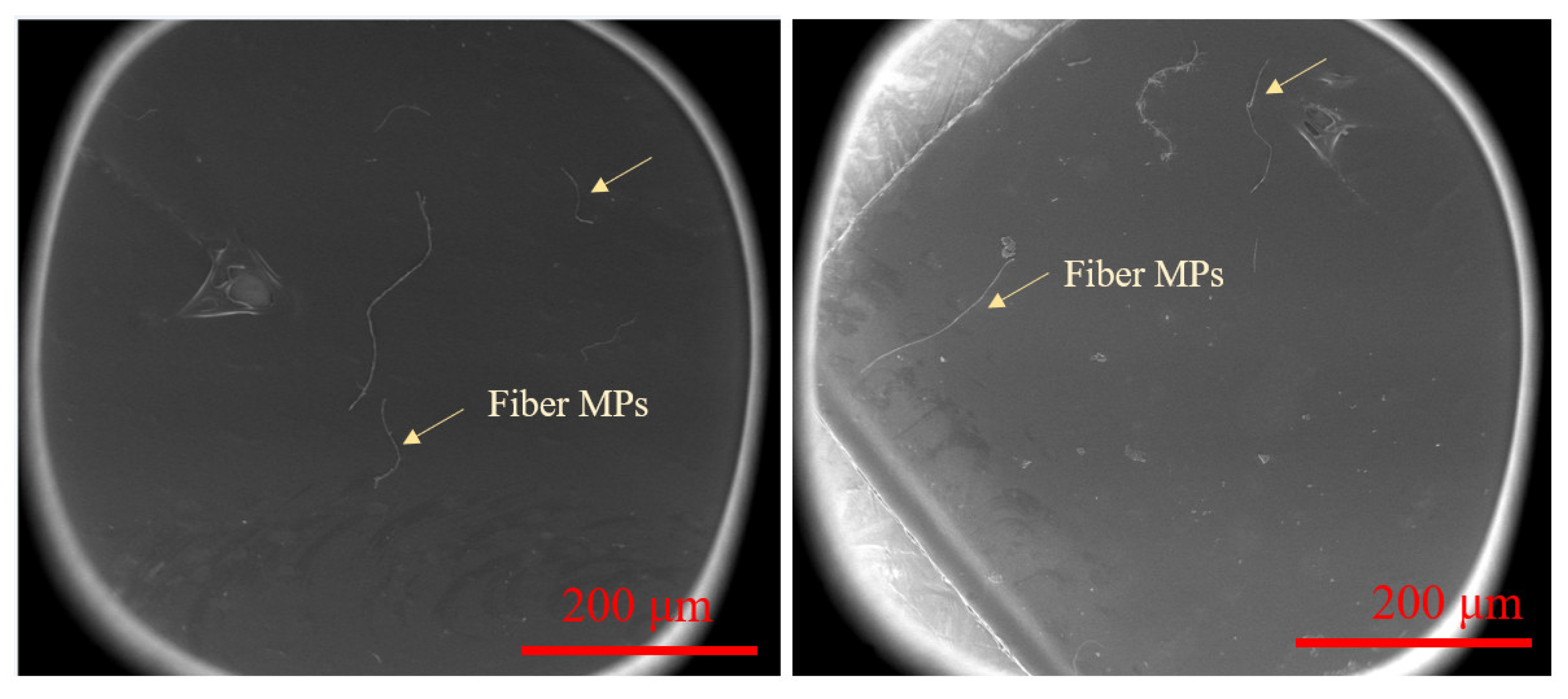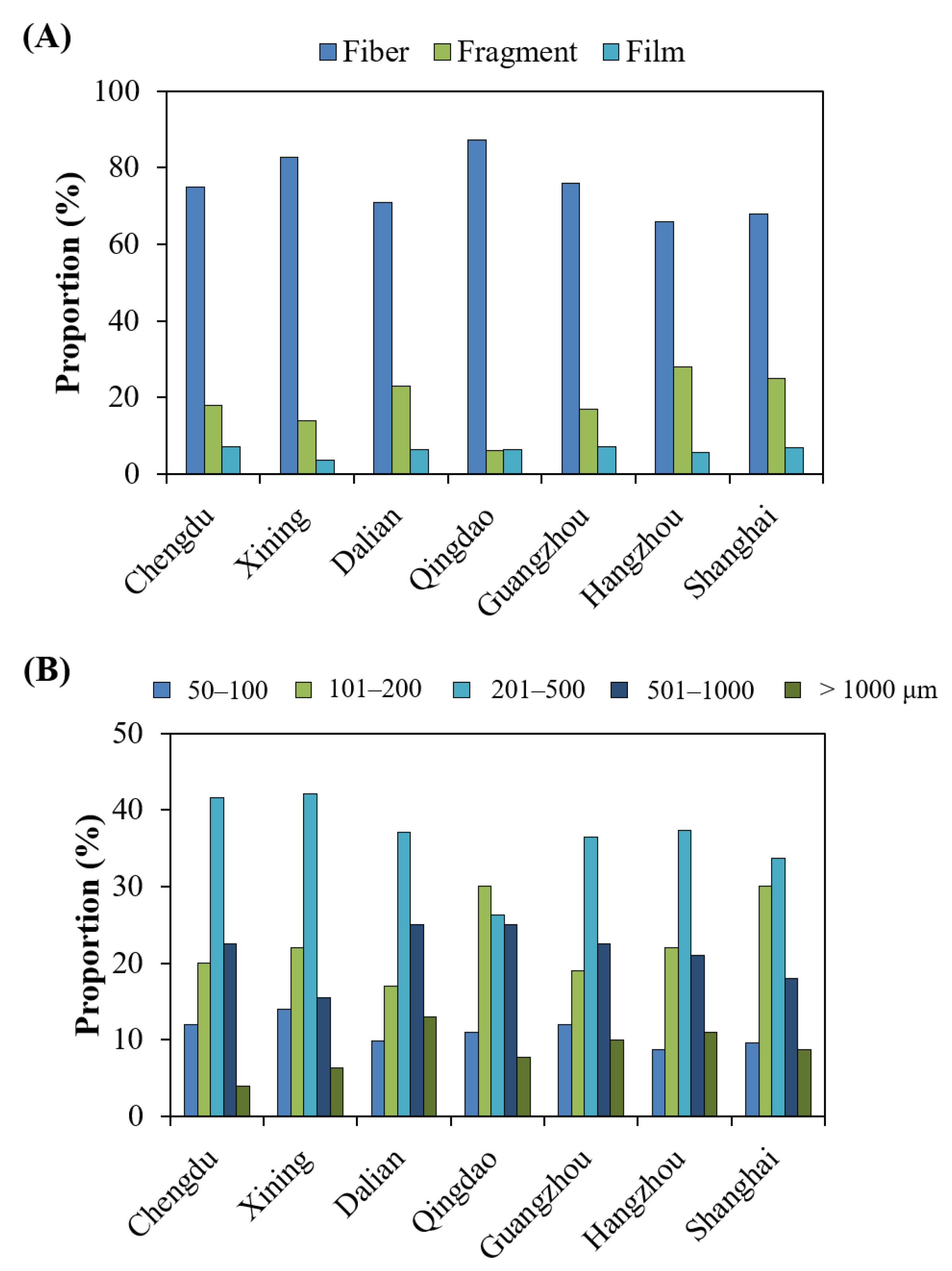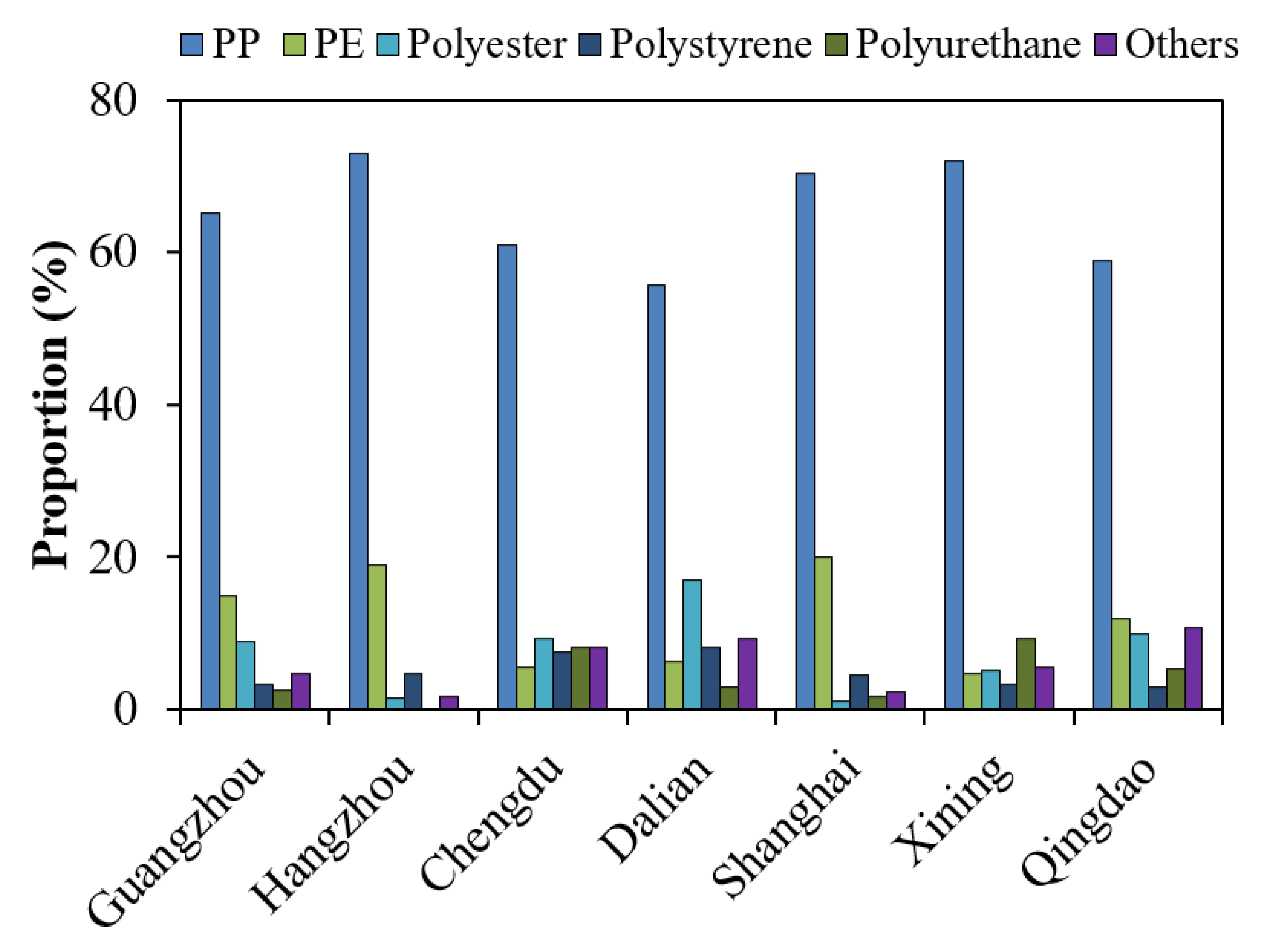Microplastics in Widely Used Polypropylene-Made Food Containers
Abstract
1. Introduction
2. Materials and Methods
2.1. Sample Collection
2.2. SEM Imaging
2.3. Sample Treatment
2.4. Detection and Analysis of MPs
2.5. Daily Intake Calculation for MPs
2.6. QA/QC
3. Results
3.1. Abundance of MPs in TOFCs
3.2. Shape and Size of MPs in TOFCs
3.3. Color and Polymer Composition of MPs in TOFCs
3.4. Estimated Daily Intake of MPs
4. Discussion
5. Conclusions
Supplementary Materials
Author Contributions
Funding
Institutional Review Board Statement
Informed Consent Statement
Data Availability Statement
Conflicts of Interest
References
- Huang, S.; Huang, X.; Bi, R.; Guo, Q.; Yu, X.; Zeng, Q.; Huang, Z.; Liu, T.; Wu, H.; Chen, Y.; et al. Detection and Analysis of Micro plastics in Human Sputum. Environ. Sci. Technol. 2022, 56, 2476–2486. [Google Scholar] [CrossRef] [PubMed]
- Ahmed, R.; Hamid, A.K.; Krebsbach, S.A.; He, J.; Wang, D. Critical review of microplastics removal from the environment. Chemosphere 2022, 293, 133557. [Google Scholar] [CrossRef] [PubMed]
- Ncube, L.K.; Ude, A.U.; Ogunmuyiwa, E.N.; Zulkifli, R.; Beas, I.N. Environmental Impact of Food Packaging Materials: A Review of Contemporary Development from Conventional Plastics to Polylactic Acid Based Materials. Materials 2020, 13, 4994. [Google Scholar] [CrossRef] [PubMed]
- Napper, I.E.; Thompson, R.C. Plastic Debris in the Marine Environment: History and Future Challenges. Glob. Chall 2020, 4, 1900081. [Google Scholar] [CrossRef] [PubMed]
- Wu, P.; Li, J.; Lu, X.; Tang, Y.; Cai, Z. Release of tens of thousands of microfibers from discarded face masks under simulated envi ronmental conditions. Sci. Total Environ. 2022, 806, 150458. [Google Scholar] [CrossRef]
- Jiang, B.; Kauffman, A.E.; Li, L.; McFee, W.; Cai, B.; Weinstein, J.; Lead, J.R.; Chatterjee, S.; Scott, G.I.; Xiao, S. Health impacts of environmental contamination of micro- and nanoplastics: A review. Environ. Health Prev. Med. 2020, 25, 29. [Google Scholar] [CrossRef]
- Birch, Q.T.; Potter, P.M.; Pinto, P.X.; Dionysiou, D.D.; Al-Abed, S.R. Sources. transport, measurement and impact of nano and micro plastics in urban watersheds. Rev. Environ. Sci. Biotechnol. 2020, 19, 275–336. [Google Scholar] [CrossRef]
- Wu, P.; Huang, J.; Zheng, Y.; Yang, Y.; Zhang, Y.; He, F.; Chen, H.; Quan, G.; Yan, J.; Li, T.; et al. Environmental occurrences. fate, and impacts of microplastics. Ecotoxicol. Environ. Saf. 2019, 184, 109612. [Google Scholar] [CrossRef]
- Enyoh, C.E.; Verla, A.W.; Verla, E.N.; Ibe, F.C.; Amaobi, C.E. Airborne microplastics: A review study on method for analysis. Occur rence, movement and risks. Environ. Monit. Assess. 2019, 191, 668. [Google Scholar] [CrossRef]
- Gurjar, U.R.; Xavier, K.A.M.; Shukla, S.P.; Jaiswar, A.K.; Deshmukhe, G.; Nayak, B.B. Microplastic pollution in coastal ecosystem off Mumbai coast. India. Chemosphere 2022, 288, 132484. [Google Scholar] [CrossRef]
- Haddout, S.; Gimiliani, G.T.; Priya, K.L.; Hoguane, A.M.; Casila, J.C.C.; Ljubenkov, I. Microplastics in surface waters and sediments in the sebou estuary and Atlantic Coast. Morocco. Anal. Lett. 2022, 55, 256–268. [Google Scholar] [CrossRef]
- Qu, J.; Wu, P.; Pan, G.; Li, J.; Jin, H. Microplastics in Seawater, Sediment, and Organisms from Hangzhou Bay. Mar. Pollut. Bull. 2022, 181, 113940. [Google Scholar] [CrossRef] [PubMed]
- Cox, K.D.; Covernton, G.A.; Davies, H.L.; Dower, J.F.; Juanes, F.; Dudas, S.E. Human Consumption of Microplastics. Environ. Sci. Technol. 2019, 53, 7068–7074. [Google Scholar] [CrossRef] [PubMed]
- Wright, S.L.; Kelly, F.J. Plastic and Human Health: A Micro Issue? Environ. Sci. Technol. 2017, 51, 6634–6647. [Google Scholar] [CrossRef] [PubMed]
- Brown, D.M.; Wilson, M.R.; MacNee, W.; Stone, V.; Donaldson, K. Size-dependent proinflammatory effects of ultrafine polystyrene particles: A role for surface area and oxidative stress in the enhanced activity of ultrafines. Toxicol. Appl. Pharm. 2001, 175, 191–199. [Google Scholar] [CrossRef]
- Deng, Y.; Zhang, Y.; Lemos, B.; Ren, H. Tissue accumulation of microplastics in mice and biomarker responses suggest widespread health risks of exposure. Sci. Rep. 2017, 7, 46687. [Google Scholar] [CrossRef]
- Liu, Q.; Schauer, J. Airborne microplastics from waste as a transmission vector for COVID-19. Aerosol Air Qual. Res. 2021, 21, 200439. [Google Scholar] [CrossRef]
- Wang, L.; Wu, W.-M.; Bolan, N.S.; Tsang, D.C.W.; Li, Y.; Qin, M.; Hou, D. Environmental fate, toxicity and risk management strat egies of nanoplastics in the environment: Current status and future perspectives. J. Hazard. Mater. 2021, 401, 123415. [Google Scholar] [CrossRef]
- Arienzo, M.; Ferrara, L.; Trifuoggi, M. The dual role of microplastics in marine environment: Sink and vectors of pollutants. J. Mar. Sci. Eng. 2021, 9, 642. [Google Scholar] [CrossRef]
- Amato-Lourenco, L.F.; Galvao, L.D.S.; de Weger, L.A.; Hiemstra, P.S.; Vijver, M.G.; Mauad, T. An emerging class of air pollutants: Potential effects of microplastics to respiratory human health? Sci. Total Environ. 2020, 749, 141676. [Google Scholar] [CrossRef]
- Karbalaei, S.; Hanachi, P.; Walker, T.R.; Cole, M. Occurrence. sources, human health impacts and mitigation of microplastic pollution. Environ. Sci. Pollut. Res. Int. 2018, 25, 36046–36063. [Google Scholar] [PubMed]
- Zhang, Q.; Xu, E.G.; Li, J.; Chen, Q.; Ma, L.; Zeng, E.Y.; Shi, H. A Review of Microplastics in Table Salt. Drinking Water, and Air: Direct Human Exposure. Environ. Sci. Technol. 2020, 54, 3740–3751. [Google Scholar] [CrossRef] [PubMed]
- Amato-Lourenco, L.F.; Carvalho-Oliveira, R.; Junior, G.R.; Galvao, L.D.S.; Ando, R.A.; Mauad, T. Presence of airborne microplastics in human lung tissue. J. Hazard. Mater. 2021, 416, 126124. [Google Scholar] [CrossRef] [PubMed]
- Yan, Z.; Liu, Y.; Zhang, T.; Zhang, F.; Ren, H.; Zhang, Y. Analysis of Microplastics in Human Feces Reveals a Correlation between Fecal Microplastics and Inflammatory Bowel Disease Status. Environ. Sci Technol. 2022, 56, 414–421. [Google Scholar] [CrossRef]
- Zhu, J.; Zhang, X.; Liao, K.; Wu, P.; Jin, H. Microplastics in dust from different indoor environments. Sci. Total Environ. 2022, 833, 15525. [Google Scholar] [CrossRef]
- Wang, Q.; Zhu, X.; Hou, C.; Wu, Y.; Teng, J.; Zhang, C.; Tan, H.; Shan, E.; Zhang, W.; Zhao, J. Microplastic uptake in commercial fishes from the Bohai Sea. China. Chemosphere 2021, 263, 127962. [Google Scholar] [CrossRef]
- Hernandez, L.M.; Xu, E.G.; Larsson, H.C.E.; Tahara, R.; Maisuria, V.B.; Tufenkji, N. Plastic Teabags Release Billions of Microparticles and Nanoparticles into Tea. Environ. Sci. Technol. 2019, 53, 12300–12310. [Google Scholar] [CrossRef]
- Jin, M.; Wang, X.; Ren, T.; Wang, J.; Shan, J. Microplastics contamination in food and beverages: Direct exposure to humans. J. Food Sci. 2021, 86, 2816–2837. [Google Scholar] [CrossRef]
- Trachana, V.; Ntoumou, E.; Anastasopoulou, L.; Tsezou, A. Studying microRNAs in osteoarthritis: Critical overview of different analytical approaches. Mech. Ageing Dev. 2018, 171, 15–23. [Google Scholar] [CrossRef]
- Wang, Y.; Wang, L.; Xue, H.; Qu, W. A Review of the Growth of the Fast Food Industry in China and Its Potential Impact on Obesity. Int. J. Environ. Res. Public Health 2016, 13, 1112. [Google Scholar] [CrossRef]
- Chen, Y.; Awasthi, A.K.; Wei, F.; Tan, Q.; Li, J. Single-use plastics: Production. usage, disposal, and adverse impacts. Sci. Total Environ. 2021, 752, 141772. [Google Scholar] [CrossRef] [PubMed]
- Liu, G.; Agostinho, F.; Duan, H.; Song, G.; Wang, X.; Giannetti, B.F.; Santagata, R.; Casazza, M.; Lega, M. Environmental impacts characterization of packaging waste generated by urban food delivery services. A big-data analysis in Jing-Jin-Ji region (China). Waste Manag. 2020, 117, 157–169. [Google Scholar] [CrossRef] [PubMed]
- Fadare, O.O.; Wan, B.; Guo, L.H.; Zhao, L. Microplastics from consumer plastic food containers: Are we consuming it? Chemosphere 2020, 253, 126787. [Google Scholar] [CrossRef] [PubMed]
- Du, F.; Cai, H.; Zhang, Q.; Chen, Q.; Shi, H. Microplastics in take-out food containers. J. Hazard. Mater. 2020, 399, 122969. [Google Scholar] [CrossRef] [PubMed]
- Patricio Silva, A.L.; Prata, J.C.; Walker, T.R.; Duarte, A.C.; Ouyang, W.; Barcelo, D.; Rocha-Santos, T. Increased plastic pollution due to COVID-19 pandemic: Challenges and recommendations. Chem. Eng. J. 2021, 405, 126683. [Google Scholar] [CrossRef] [PubMed]
- Parashar, N.; Hait, S. Plastics in the time of COVID-19 pandemic: Protector or polluter? Sci. Total Environ. 2021, 759, 144274. [Google Scholar] [CrossRef] [PubMed]
- Lithner, D.; Nordensvan, I.; Dave, G. Comparative acute toxicity of leachates from plastic products made of polypropylene. Polyeth ylene, PVC, acrylonitrile-butadiene-styrene, and epoxy to Daphnia magna. Environ. Sci. Pollut Res. Int. 2012, 19, 1763–1772. [Google Scholar] [CrossRef] [PubMed]
- Liu, G.; Wang, J.; Wang, M.; Ying, R.; Li, X.; Hu, Z.; Zhang, Y. Disposable plastic materials release microplastics and harmful sub stances in hot water. Sci. Total Environ. 2022, 818, 151685. [Google Scholar] [CrossRef]
- He, Y.J.; Qin, Y.; Zhang, T.L.; Zhu, Y.Y.; Wang, Z.J.; Zhou, Z.S.; Xie, T.Z.; Luo, X.D. Migration of (non-) intentionally added substances and microplastics from microwavable plastic food containers. J. Hazard. Mater. 2021, 417, 126074. [Google Scholar] [CrossRef]
- Peller, J.R.; Mezyk, S.P.; Shidler, S.; Castleman, J.; Kaiser, S.; Faulkner, R.F.; Pilgrim, C.D.; Wilson, A.; Martens, S.; Horne, G.P. Facile nanoplastics formation from macro and microplastics in aqueous media. Environ. Pollut. 2022, 313, 120171. [Google Scholar] [CrossRef]
- Yang, X.; Li, Y.; Ma, G.; Hu, X.; Wang, J.; Cui, C.; Wang, Z.; Yu, W.; Yang, Z.; Zhai, F. Study on weight and height of the Chinese people and the differences between 1992 and 2002. Chin. J. Epidemiol. 2005, 26, 489–493. [Google Scholar]
- Nematollahi, M.J.; Zarei, F.; Keshavarzi, B.; Zarei, M.; Moore, F.; Busquets, R.; Kelly, F.J. Microplastic occurrence in settled indoor dust in schools. Sci Total Environ. 2021, 807, 150984. [Google Scholar] [CrossRef] [PubMed]
- Bogdanowicz, A.; Zubrowska-Sudol, M.; Krasinski, A.; Sudol, M. Cross-Contamination as a Problem in Collection and Analysis of Environmental Samples Containing Microplastics—A Review. Sustainability 2021, 13, 12123. [Google Scholar] [CrossRef]
- Zhou, X.J.; Wang, J.; Ren, J.F. Analysis of Microplastics. in Takeaway Food Containers in China Using FPA-FTIR Whole Filter Analysis. Molecules 2022, 27, 2646. [Google Scholar] [CrossRef] [PubMed]
- Liu, K.; Wang, X.; Fang, T.; Xu, P.; Zhu, L.; Li, D. Source and potential risk assessment of suspended atmospheric microplastics in Shanghai. Sci. Total Environ. 2019, 675, 462–471. [Google Scholar] [CrossRef]
- Zhang, Q.; Zhao, Y.; Du, F.; Cai, H.; Wang, G.; Shi, H. Microplastic Fallout in Different Indoor Environments. Environ. Sci. Technol. 2020, 54, 6530–6539. [Google Scholar] [CrossRef]
- Liao, Z.; Ji, X.; Ma, Y.; Lv, B.; Huang, W.; Zhu, X.; Fang, M.; Wang, Q.; Wang, X.; Dahlgren, R.; et al. Airborne microplastics in indoor and outdoor environments of a coastal city in Eastern China. J. Hazard. Mater. 2021, 417, 126007. [Google Scholar] [CrossRef]
- Chen, G.; Feng, Q.; Wang, J. Mini-review of microplastics in the atmosphere and their risks to humans. Sci. Total Environ. 2020, 703, 135504. [Google Scholar] [CrossRef]
- Saravanja, A.; Pusic, T.; Dekanic, T. Microplastics in Wastewater by Washing Polyester Fabrics. Materials 2022, 15, 2683. [Google Scholar] [CrossRef]
- Dalla Fontana, G.; Mossotti, R.; Montarsolo, A. Assessment of microplastics release from polyester fabrics: The impact of different washing conditions. Environ. Pollut. 2020, 264, 113960. [Google Scholar] [CrossRef]
- Carrion, F.; Montalban, L.; Real, J.I.; Real, T. Mechanical and physical properties of polyester polymer concrete using recycled aggre gates from concrete sleepers. Sci. World J. 2014, 2014, 526346. [Google Scholar] [CrossRef] [PubMed]
- NDRC. National Development and Reform Commission. Features of Chinas Catering Industry. 2019. Available online: https://www.ndrc.gov.cn/fgsj/tjsj/cyfz/fwyfz/201906/t20190628_1148432.html (accessed on 17 September 2021).
- Kim, J.S.; Lee, H.J.; Kim, S.K.; Kim, H.J. Global Pattern of Microplastics (MPs) in Commercial Food-Grade Salts: Sea Salt as an Indicator of Seawater MP Pollution. Environ. Sci. Technol. 2018, 52, 12819–12828. [Google Scholar] [CrossRef] [PubMed]
- Dehghani, S.; Moore, F.; Aghazadeh, R. Microplastic pollution in deposited urban dust. Tehran metropolis, Iran. Environ. Sci. Pollut. Res. Int. 2017, 24, 20360–20371. [Google Scholar] [CrossRef] [PubMed]




| Sampling Site | Mean | Median | SD | Range |
|---|---|---|---|---|
| Chengdu (n = 27) | 25 | 27 | 9.3 | 10–43 |
| Xining (n = 37) | 23 | 26 | 10 | 9–40 |
| Dalian (n = 32) | 16 | 12 | 7.5 | 7–27 |
| Qingdao (n = 28) | 14 | 18 | 8.7 | 7–21 |
| Guangzhou (n = 21) | 13 | 11 | 6.0 | 6–28 |
| Hangzhou (n = 35) | 11 | 9.7 | 5.5 | 8–16 |
| Shanghai (n = 30) | 8.7 | 10 | 4.4 | 3–18 |
| Chengdu | Xining | Dalian | Qingdao | Guangzhou | Hangzhou | Shanghai | |
|---|---|---|---|---|---|---|---|
| women | |||||||
| Mean | 0.14 | 0.13 | 0.088 | 0.080 | 0.071 | 0.063 | 0.049 |
| Median | 0.16 | 0.15 | 0.091 | 0.077 | 0.082 | 0.058 | 0.050 |
| Range | 0.057–0.24 | 0.051–0.23 | 0.040–0.15 | 0.040–0.12 | 0.034–0.16 | 0.045–0.091 | 0.017–0.10 |
| men | |||||||
| Mean | 0.12 | 0.11 | 0.075 | 0.067 | 0.060 | 0.053 | 0.042 |
| Median | 0.13 | 0.12 | 0.080 | 0.072 | 0.058 | 0.054 | 0.046 |
| Range | 0.048–0.21 | 0.043–0.19 | 0.034–0.13 | 0.034–0.10 | 0.029–0.13 | 0.038–0.077 | 0.014–0.087 |
Publisher’s Note: MDPI stays neutral with regard to jurisdictional claims in published maps and institutional affiliations. |
© 2022 by the authors. Licensee MDPI, Basel, Switzerland. This article is an open access article distributed under the terms and conditions of the Creative Commons Attribution (CC BY) license (https://creativecommons.org/licenses/by/4.0/).
Share and Cite
Hu, J.; Xu, X.; Song, Y.; Liu, W.; Zhu, J.; Jin, H.; Meng, Z. Microplastics in Widely Used Polypropylene-Made Food Containers. Toxics 2022, 10, 762. https://doi.org/10.3390/toxics10120762
Hu J, Xu X, Song Y, Liu W, Zhu J, Jin H, Meng Z. Microplastics in Widely Used Polypropylene-Made Food Containers. Toxics. 2022; 10(12):762. https://doi.org/10.3390/toxics10120762
Chicago/Turabian StyleHu, Jun, Xin Xu, Ying Song, Wenqi Liu, Jianqiang Zhu, Hangbiao Jin, and Zhu Meng. 2022. "Microplastics in Widely Used Polypropylene-Made Food Containers" Toxics 10, no. 12: 762. https://doi.org/10.3390/toxics10120762
APA StyleHu, J., Xu, X., Song, Y., Liu, W., Zhu, J., Jin, H., & Meng, Z. (2022). Microplastics in Widely Used Polypropylene-Made Food Containers. Toxics, 10(12), 762. https://doi.org/10.3390/toxics10120762









